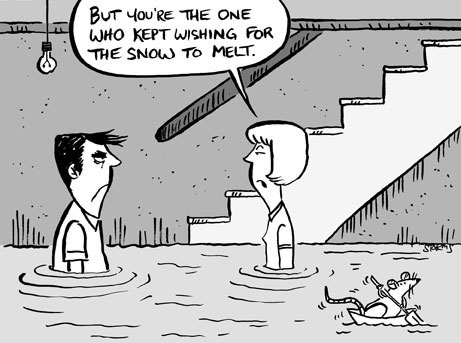 Mold surrounds us everywhere in nature. It is a naturally occuring organism that plays an important role in our environment. These tiny spores are small enough and light enough to float. Eventually, these mold spores will make their way into our homes, where they settle and sometimes begin to reproduce and grow if the conditions are right.
Mold surrounds us everywhere in nature. It is a naturally occuring organism that plays an important role in our environment. These tiny spores are small enough and light enough to float. Eventually, these mold spores will make their way into our homes, where they settle and sometimes begin to reproduce and grow if the conditions are right.
For the most part, mold spores have no negative affects when they enter our homes. However, if they find a damp or wet spot, like our basements, or other areas of moisture intrusion, the spores can begin to grow and reproduce. Now, you are faced with some uninvited guests that don’t want to leave and can be quite a nuisance to get rid of. Unfortunately, the presence of these unwanted guests can cause severe health problems when inside our home. Often, molds can produce allergens, irritants, and with certain molds, even produce toxic substances known as mycotoxins.
For those with asthma, mold contaminations can even trigger severe asthmatic attacks and impact our everyday functioning. In addition to the many potential health hazards that presence of mold can cause, their visit can also do damage to surfaces such as wood, drywall and many household fabrics, and can even start to fill your home with unwanted and uncomfortable odours. So, it’s always beneficial to know how to prevent and remove basement mold, as well as other areas of your home.
 Basement Mold: How Does it Get There?
Basement Mold: How Does it Get There?
Mold is often found in our basements as a result of flooding or water leakages. Since water will also take the path of least resistance, it often makes its way to our basements as gravity pulls it downwards.
- Flooding – As we stated above, water runs downhill. When flooding occurs, water will almost always make its way into your basement through cracks in your foundation or walls. Even once other parts of your home have dried, water can remain in your basement due to the lower temperatures.
- Water leaks – Much like floods, water leaks caused by broken pipes will often result in basement puddling. The water/moisture will remain longer than is most other rooms due to the lower temperature and humidity.
- Condensation – Heat rises which is why many basements are cooler than most other rooms. This is especially true in older homes where insulation standards may be lower. As humidity rises, the colder basements can start to sweat and condensate, creating a dark, damp environment – perfect for mold growth.
 Basement Mold Prevention
Basement Mold Prevention
Whether you’ve found mold in your basement and want to prevent it from spreading further,there is one simple practice that you must follow.
- Control the moisture – Whether you had a flood, leaking pipes, condensation or all three, controlling the moisture as quickly as possible is the key to mold growth prevention. As soon as water or moisture enters your basement, or any room in your home, your job is to mop up the water and dry all structures and materials that are wet. For added assurance, use a fan to help saturated materials to dry quicker and use a dehumidifier to pull moisture out of the surrounding air.
Other measures to prevent mold growth from forming in your basement include immediately fixing any water leaks or flood entry points that may be present within your space. Further insulating your basement can also help keep condensation levels down.
Basement Mold Removal
It’s important to remove any mold that you find in your basement as quickly as possible. Mold can have harmful health effects for those sensitive to allergens or have any sort of immune-suppression. Thankfully, unless the damage is too great, most furnishings and items can be salvaged. Before starting any mold removal project, it’s important to call in the experts. Professional mold assessment and air quality testing professionals can help assess your situation to ensure the mold is isolated to a specific area, and has not spread to multiple locations throughout your home. This is important so that you know that once the area in question is cleaned, you are not leaving something else behind that may continue to re-contaminate the space over, and over again.
If it is determined that the mold contamination present within your home is less than 10 sq. ft. in size, the mold removal is something you can handle on your, if you so choose. If you are uncomfortable handling this yourself, or the contamination is larger than 10 sq. ft. in size, you may choose to call in a Mold Removal Specialist to assist.
For those who wants to try to clean the mold themselves check out these mold cleanup guides.
Protective Gear
When removing mold from your basement, it’s important to make sure that you avoid contact with the mold as well as avoid inhaling any of the mold spores. When working with mold, be sure to wear protective clothing so that no mold ends up on your clothes. Also, it’s advisable you wear a N-95 respirator/P-100 mask, as well as gloves and properly fitted goggles.
When working on removing mold, it’s important to always use extreme caution, and don’t slack on the protective gear! Precautions need to be taken so that you, those around you, and the environment are as safe as possible.
(Visited 301 times, 1 visits today)







 Basement Mold: How Does it Get There?
Basement Mold: How Does it Get There? Basement Mold Prevention
Basement Mold Prevention